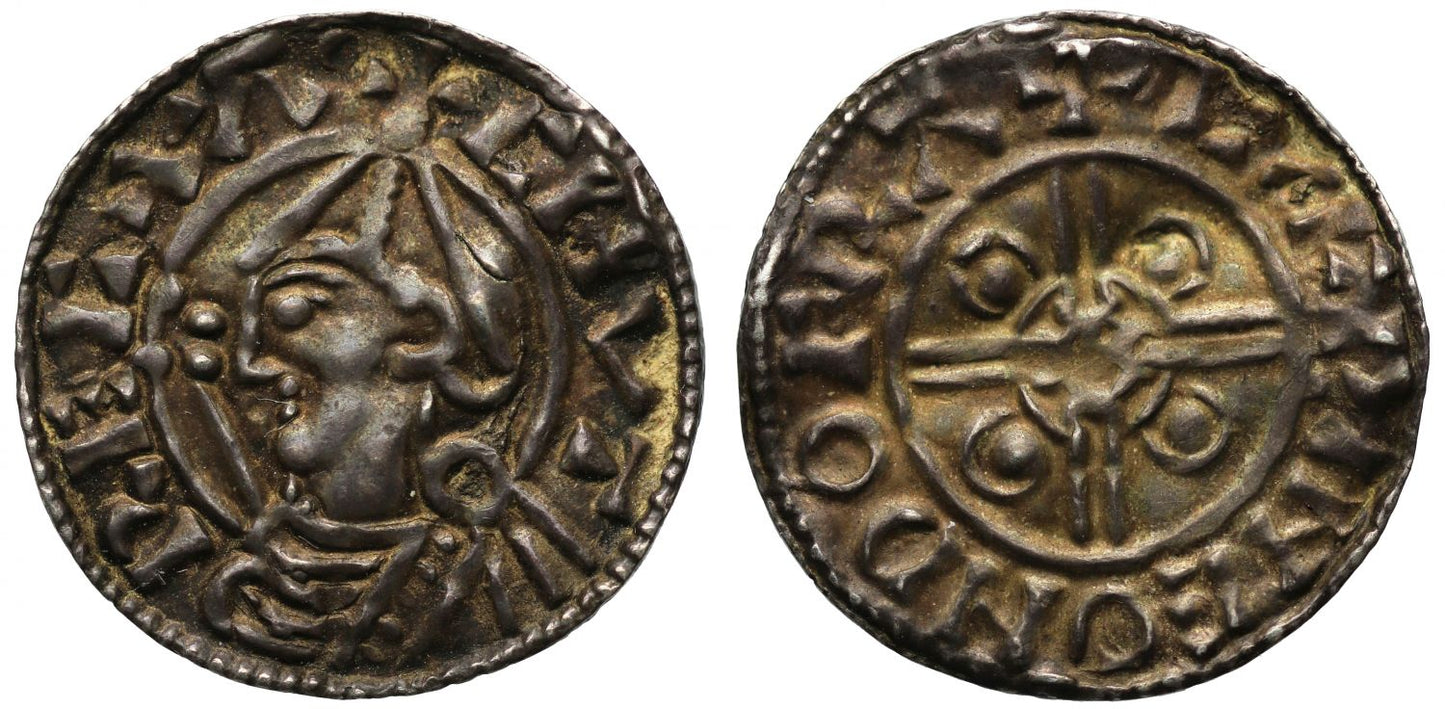FAQs
What makes a coin valuable?
I have coins to sell, what’s the next step?
How will my purchases be shipped?
What happens if I’m not entirely happy with my purchase?
Canute Penny, Helmet type, Dover Mint, Moneyer Leofwine
Canute (1016-35),silver helmet type Penny (1024-30), Dover Mint, Moneyer Leofwine, helmeted bust left with sceptre, legend surrounding commencing at top, CNVT RECX A.,rev.pellet in double annulet at centre of voided short cross, broken annulet enclosing pellet in each angle, linear circles and legend surrounding, +LVFPINE ON DOFRA, weight 0.99g (SCBI Copenhagen 13:379-384; BMC type XIV; N.787; S.1158).Toned with flan a little undulating, good very fine and pleasing to see quite a full mint signature.
The legends translate as "Canute King of the English" on obverse and on the reverse "Leofwine of Dover."
Despite Canute being essentially a Viking King from overseas, the coinages of England continued in a similar vein to those of Aethelred II, in that the types changed every six years, meaning there are three main types for this reign, of which the quatrefoil type was the first. According to North there were up to 74 mints in operation with perhaps four other enigmatic places that remain uncertain. North records fourteen different moneyers working at Dover in his reign through five types.
Canute could have been as young as 21 when he ascended the English throne after the 28th November 1016 upon the death of Edmund "Ironside" at Oxford. Though Edmund son of Aethelred II had a younger brother and two infant sons his advisers recognized Canute as successor. Though his birth date is not known, Canute was a commander in his Father's army from 1012, and at first had to settle a number of uprisings amongst the nobility and others, which he quelled by maintaining a large army and navy from heavy taxation. He kept Wessex at first for himself whilst dividing up other areas for regional government under trusted Danish allies. Canute had married Aelfgifu daughter of Ealdorman Aelfhelm of Northumbria, but set her aside to marry Aethelred's widow Emma in 1017 who had fled to Normandy, and this latter union helped maintain the political continuity and tradition of English Kingship. Harald of Denmark died childless in 1018 and Canute used his English troops and finance to extend power to Scandanvia making his infant son Harthacanute titular Governor and heir of Denmark. Canute attempted to invade Sweden, and actually took Norway in 1028 having had a pilgrimage to Rome the year before. Canute left his eldest son by Aelfgifu, Swein to rule Norway and was now the most powerful King of England ever at this time and is likely when the apocryphal story of him trying to vainly order the coastal tide to turn and retreat in front of his courtiers emerged. However, Norway was lost by 1034, Canute did not respond, and he passed away suddenly at Shaftesbury in his mid-forties on the 12th November 1035.
One of the "Cinque Ports" of the south-east corner of England on the edge of the "Garden of England" county of Kent, this major port for the continent has had a castle with foundation from a very early time. In 1050 Edward the Confessor ordered Earl Godwine to harry the port after his Sister and her husband suffered an affray in Dover, but the Earl refused. Later the castle surrendered without a fight to William the Conqueror in 1066, but the town was still looted and burnt. Later Dover was a stronghold for the Angevin party and capitulated to Stephen in 1138. Minting activity occurs from the reign of Aethelstan until King Stephen.
Provenance:
Purchased from A. H. Baldwin January 2020, ex vault stock.
Ex Collection of an English Doctor part II, Sovereign Rarities fixed price list online May 2022.
FAQs
What makes a coin valuable?
I have coins to sell, what’s the next step?
How will my purchases be shipped?
What happens if I’m not entirely happy with my purchase?













